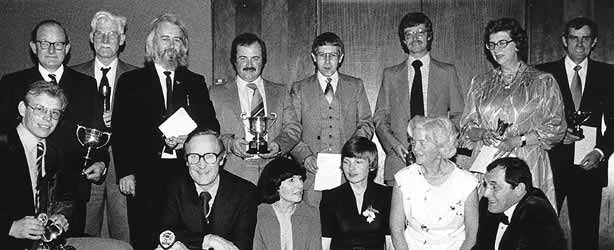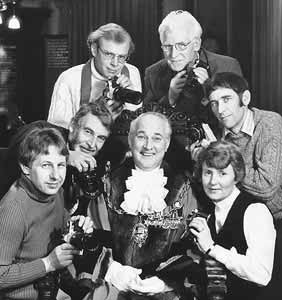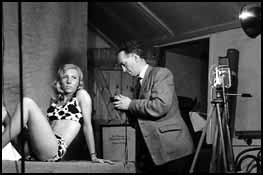Maidstone Camera Club was founded in 1902 as ‘The Maidstone & Institute Camera Club’.
Up to now little was known about the Club’s early activities; the records only show that its members met at the Church Institute in the town. However, recently some prints have some to light that were taken by Club members including a photo that shows a Mr. Ruck a club member. These photos were taken in the early part of the 20th century as part of the Photographic Survey & Record of Kent. Click to see photos. In the early 1920s the Club underwent the first of its many name changes to become the ‘Maidstone and District Photographic Society’. At that time its subscription was set at 10/- (50p) and its membership numbered 59. The Club Officers being: Reverend A Gatehouse (President) H. W. Whitcombe (Chairman) and J. H. Baker (Secretary).
Affiliation dated 25 July 1923
With the start of the war the Club inevitably went into limbo and its trophies were moved for safe keeping to Maidstone Museum. The Society was reformed in 1945 under the Presidency of Mr Whitcombe with another new name, ‘Maidstone Photographic Society’. The new Club met at the Boys Technical School, Tonbridge Road where they had their own dark room facilities. Two notable members at that time were Mr Sloman and Mr Pettitt who subsequently started a photographic business in the town which was still trading in Pudding Lane up to 2004. The business now operates from premises in Chatham. During 1949 the Club awarded its first Honorary Life Membership to Mr Hillier a noted Bromide worker and Mr Marley donated the medal that we now compete for in the Marley Medallion Competition. Around this period Mr Whitcombe retired as President and in recognition of his contribution to the Club over the previous decade he was awarded the Club’s first Honorary Vice Presidency.
In the early fifties the Club played an important role in the formation of the Kent County Photographic Association. Up to this time, Kent clubs relied on lecturers and judges, drawn from the lists of the Central Association based in London but it became increasingly difficult to find judges willing to travel to evening meetings in Kent. So, in 1951, Maidstone, Medway, Folkestone, Canterbury and Tunbridge Wells clubs met to discuss the formation of a Kent based association which would provide its own list of local judges and lecturers. Subsequently, a meeting of delegates f rom all the clubs in Kent took place in Maidstone under the chairmanship of Bob Skinner, then Chairman of Maidstone Photographic Society. A constitution and rules were drawn up, M W Handley of Eltham was elected the first President, Bob Skinner, Secretary and Doug Randall of Medway, Honorary Treasurer.
At this time most clubs held their own annual exhibition as they do today; it was however customary to invite other clubs to display panels at these exhibitions. Inevitably, with the formation of the KCPA, this practice led to the idea of the association holding its own exhibition in which all the clubs could participate. The first of these was held at Maidstone in 1951 as part of the Festival of Britain celebrations. With the donation of a cup by Mr Ross for the winning club in these exhibitions, this event evolved into the inter-club print competition we know today as the Ross Cup.An interesting insight into the Club at this time was the monthly print competitions. Prints, the size of which could not exceed 10” by 8”, were sent to a judge (the same one was used all season). He awarded ten marks for print quality and ten for pictorial merit and then wrote his comments on the reverse of each print before returning them. The Club flourished during the fifties under the guidance of three distinguished members; Mr E C Wood who held the Presidency, Bill Skinner the Chairman, renowned for his landscapes and in particular the preparation he put into his prints, and Miss Glenn the Secretary. Miss Glenn who subsequently became Chairman and then President was well known for her superb close ups of plants. She always gave a great deal of encouragement to beginners and this is recognised in the Liz Glenn trophies that are still awarded at the end of each season to the winners of each section in the monthly print and slide competitions. Due probably to the low number of cars owned by members, Club field trips formed an important part of the Club’s calender during the fifties. Trips to places such as London Zoo, Agilux (camera manufacturers in Croydon) and a tour of the London Docks and Tower Bridge proved very popular. Members travelled to London for the Coronation, sitting out all night to obtain the best view. Activities within the Club at the time put great emphasis on the practical side of photography with studio sessions for the ‘advanced’ at Sloman and Pettitt’s studios.
In September 1959 a Specialist General Meeting was held to formalise the activities of the Club. This resulted in the Club changing its name to its present form, Maidstone Camera Club, and the ratification of a constitution. The Club had now vacated the Boys Technical School and was using the Old Palace for meetings.
During the sixties the Club fortunes fluctuated. Bob Skinner resigned through ill health and moved away from the area. The membership went into decline and by the mid to late sixties numbered about 47. This caused cash flow problems which meant that many of the lectures had to be provided by members of the Club. Despite these difficulties the Club managed in 1965 to achieve third place in the KCPA Print Competition (the Ross Cup) with one member, Peter Hedgland winning the premier award. Further success followed in 1966 when the Club won the KCPA Slide Competition (the Handley Shield). However, in 1968 the Club was saddened by the death of three prominent members who had served it so well in the fifties, Bob Skinner, E Woods and Miss Glenn. In 1972 the Club was asked to vacate the meeting room in the Old Palace and it relocated to the Adult Education Centre.
In the seventies the Club, in association with Maidstone Arts Council, staged a number of major exhibitions in the town. These included one at Allington Castle and another, part of Maidstone, Heritage Exhibition, held at Rootes Car Showroom. On the 6th of August 1977 the Club moved to St Andrews Church Hall.
The following year the Club hosted the Kent versus Sussex slide competition with one of its members, Edna Groves, winning the best slide award. The preceding few years had been hard for the Club and it might not have survived but for the generosity of one member, John Arnold. In 1982 he left the Club and moved to live in Cambridgeshire; as a mark of gratitude the Club made him an Honorary Vice President for life, only the second awarded in the Club’s history.
Membership continued to increase during this time, so much so that the club decided to try and build or convert a suitable club headquarters. Lack of finance inevitably halted this ambitious plan.

Prize winners 1982: Back, Bill Ogilvie, Reg Sheppard, Eric Wilkinson, Alan Holder, Ron Gill, Dave Marsh, Freda Dwight, B.C. Shillingford. Front, Ray Bridges, Fred Dwight, Liz Stewart, Val Sloman, Edna Groves and Roy Carey
1982 saw the Club celebrate its 80th birthday with a memorable dinner and dance at Leeds Castle attended by the Mayor of Maidstone.The following year club members again went to the Town Hall to photograph the Mayor. It was hoped that this photo session and the presentation of a framed print to the Mayor at the club’s annual dinner would become an annual event.

With the Mayor of Maidstone 1983 are club members Ron Gill, Ray Saunders, Ray Bridges, Reg Sheppard, Robin Mellor and Ann Hughes
In 1984 the Club bestowed a third Honorary Vice Presidency on Reg Sheppard in appreciation of his services to the Club. During the mid eighties the Club flourished, its membership including a number of very talented print and slide workers. Despite this, success in external competitions eluded the Club. However, in 1987 the efforts of individual workers were rewarded when Joyce Sheppard received the premier award in the KCPA Slide Competition and David Marsh’s print “Mean Machine” was selected by the CA for its PAGB panel. In the same year a further Honorary Vice Presidency was bestowed by the Club on Edna Groves.
In 1988 the Club staged the KCPA Slide Competition. It was decided by Maidstone Camera Club that the display of the entries, the culmination of the competition, would be shown in the form of an A/V rounded up by composites showing each club’s entry. The use of the A/V format proved controversial and resulted in an amendment to the KCPA rules to ensure that, in future, slides would always be shown as entered by the clubs. Unfortunately the rule change was voted on prior to the actual display, which was subsequently hailed as original and well presented.
In 1988 formal procedures were established to select work for external competitions in an attempt to improve the Club’s results. Subsequently, in that year the Club won the Marley Medallion and saw improved performances in both the KCPA and CA competitions.
Individual success was also repeated in 1988 for David Marsh whose slide portrait “Lesley” was selected by the CA for its PAGB panel. In the same year Roy Carey, the President, decided to retire from work and moved away from the area. In recognition of his personal contribution to the Club he was awarded an Honorary Vice Presidency. Roy subsequently gained his Fellowship, in the applied section of the Royal Photographic Society in 1994 returning to Maidstone in 1997.
Following a decline in membership in 1989, numbers have stabilised and individual Club members have continued to be successful in external competitions with Roy Moore winning the CA’s Wastell trophy (for best slide) in 1989, followed by Derek Hodge in 1991 and Ann Hughes in 1992. 1998 saw Roy Carey awarded a gold medal for his print ‘and the band’s playing’ in the PAGB print competition, in 1999 Bea Auger gained a gold medal for her slide ‘star flyer’in the record section at the KCPA annual event, and Roy Moore received a PAGB silver medal for ‘Mach One’. The same image won the premier award at the Handley Shield in 1998, following previous club winners Edna Groves and Joyce Sheppard. Club members have also had success in aquiring photographic qualifications – Roy Carey, DPAGB; Roy Moore, DPAGB; Reg Sheppard, ARPS & DPAGB (both in a/v); Ian Corse, LRPS, Steve Carroll, ARPS and Chris Moncrieff, LBAPA & BPE2.
More and more, Maidstone have become involved with activities outside the club itself, hosting and helping with County and National events, leading to the presentation of an APAGB to Reg Sheppard for ‘services rendered to photography’.
At club level winning has almost become our expected goal, with a series of wins in the last couple of years in local club ‘battles’as well as a much improved showing in County events. These include :-1999 winners for the third year in succession of the Marley Medallion; 1999 winners of the Cobdown Shield, a print battle between 9 local clubs; and 1999 winners of the Malling Shield, a slide battle with local clubs. At County level we managed a creditable 11th place in the 1999 prestigious 32 club KCPA Ross Cup.
In 2001/2002, our Centenary season, the club continued to grow with membership increasing to over 100. Having won the Ross Cup in 2000 – our first ever win in this competition – we went on to represent Kent in the national club print championship held at Chester. The result was more than we could have expected with Maidstone finishing 16th in the UK, just a few point behind the top club.We also quaified to represent the County in the 2002 national club slide competition by finishing 2nd in the Kent championships.
But all eyes in 2002 were on two premiere Centenary events. A substantial exhibition covering the full 100 years of our clubs existence at Maidstone museum followed by a prestigious Centenary dinner and photo exhibition at Leeds Castle.
The 2003/2004 season saw more innovation from club members, with the realisation that the “Digital Revolution” was here to stay and had to be dealt with. Roy Moore disappeared into the depths of HTML code and eventually reappeared with a piece of software that he had named ‘ImageCompPro’. This enabled the Club to run competitions for digital images projected to a screen, whilst enabling the scores to be recorded together with the image title and photographer’s name. This software was made available for a nominal fee to other clubs and proved to very successlful.
But it doesn’t stop there!





